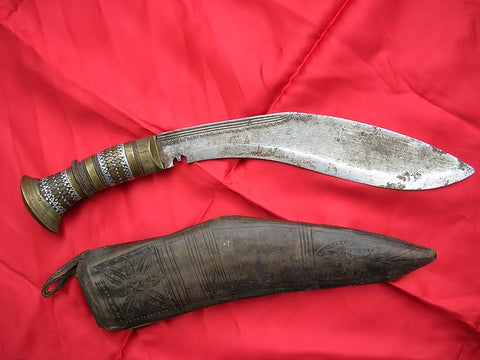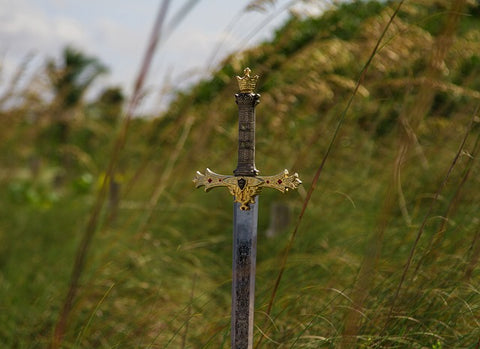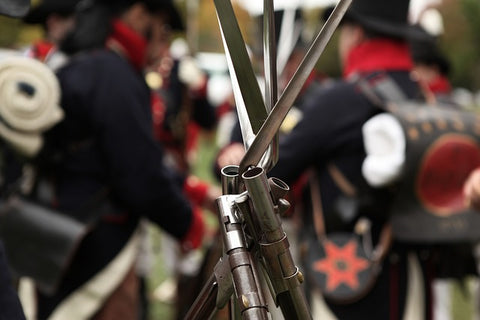
Johnny walked into the sword shop. Inside, there were swords from all eras adorning the walls. To his left, he could see swords from Europe, and to his right swords from China and Japan. At the back of the shop was the shopkeeper who looked up as the bell jingled. As Johnny approached the shopkeeper, he couldn’t stop from turning to look around him at all the different swords representing multitudes of time periods and cultures. He couldn’t help exclaiming to himself, “Ah, but which should I choose?” "That’s a great question, son,” replied the shopkeeper, who had obviously overheard Johnny’s not-quite whisper. “To know that, you’ll need to know something about the history of these fine weapons.”

The shopkeeper reached below the desk separating him from Jonny and pulled out a dagger. “Daggers were the first weapons. They are different from knives in that they are double-edged. The first daggers were developed several thousand years ago, were made from flint or bone, and were useful in that they could be used in combat without much training, just swing and stab. As time went on, copper was discovered and daggers were made of it." The shopkeeper replaced the dagger on the wall and pulled out another weapon, that looked more like a sword - but not quite.

“Now the main limitation of the earliest weapons,” the shopkeeper continued, “was that the materials they were made from were not very strong, so this limited their maximum length, and thus the wielder’s reach. Now, one of the most important factors in any fight is the idea of reach - the more of it you have, the easier it is to hit your opponent without being hit in return. Remember that. Because of this, the discovery of bronze (an alloy of copper and tin) was a revolution in weapon manufacturing. It allowed longer daggers to be constructed, and eventually led to the creation of the first swords.”
The shopkeeper turned around, and, from the wall behind him, he pulled down what could definitely be considered a sword. As he turned around to show the weapon to Johnny, he carefully unsheathed a bit of the blade. “Later on, in the 13 to 12 centuries BC, iron was discovered. At first, it didn’t have many more advantages than Bronze other than it was more common. However, because tin is rare and producing bronze from it requires much skill while working iron is substantially easier, eventually ancient swordsmiths switched to iron."

“Follow me,” the shopkeeper said as he replaced the sword back on the wall and walked out from behind the desk to some swords on the left wall. As he reached up for it and lifted it from its hanger, he continued “This sword is made in the style of the gladiators of ancient Rome. It was there that swordsmanship began to be appreciated by many. The Romans learned from other cultures about different sword techniques, including thrusting and shield blocks, and the sword became a popular fixture in gladiator fights.”
The shopkeeper continued his counterclockwise revolution around the room. As he reached up and put his hand on the next sword, he continued “The next period became darker for swords. The Romans suffered a grave defeat against a cavalry charge, and swords began to fall out of favor until a short period in the middle ages, when iron working improved and steel became commonplace allowing blades that wouldn’t break easily in fights, as they were wont to do before. However, also around this time, archery was also improving, and armor became a necessity in order to defend against arrows. Because of this, the sword quickly began to fall again into obsolescence as a weapon of battle.”

The next sword the shopkeeper reached for was longer and more ornate. “However, during this time, swords became more closely tied to religion, and with the introduction of Chivalry, a sort of mystic culture crew up around the sword. Then a funny thing began to happen. Firearms were introduced, and, as they grew in power, armor could not keep up, so armor was discarded in return for mobility, thus the sword once again became a weapon of choice for close-quarters fighting.”
“However, guns began to increase in accuracy as well as power, and swords once again fell out of use except for cavalry, as it is much easier to hit a target from horseback with a sword than with a gun at close quarters. This was the state at the beginning of WWI and continued until the invention of the tank, when swords finally lost all relevance as a weapon of modern war.”

Finally, the shopkeeper reached up toward a bayonet near the corner of a wall near the entrance. “Swords were replaced by the bayonet, which was basically a pike attached to the end of a rifle, allowing the reach and mobility of a sword at close-range with the power of a gun for long range. However, while swords were now useless for modern war, they weren't finished. As people began to enter the middle-class of modern society, the increase in free time and the availability of disposable income meant that people began taking an interest in swords once again.”
Putting the bayonet back, the shopkeeper walked to the right side of the shop filled with Katanas, Ninja blades, and other exotic swords. “You may think I’ve covered most of sword history, but in reality I’ve covered only half. Because the Eastern world was cut off from the West, they had a very different history and their swords served other purposes.”
“At first, sword development in the East followed much the same process as in the West. In fact, some of the earliest steel swords were developed in India and exported to both Europe and Asia. However, around 900 AD in Japan, the first Tachi were invented.” The shopkeeper paused and pointed to a curved sword with the cutting edge facing down. “Less famous than the later Katanas, these swords were best used by cavalry, as they were worn with the cutting edge facing down, which makes attacks from horseback more effective.”
“One interesting thing to note is that, unlike in Europe, the sword never became a primary weapon of war, but was always intended to be a secondary weapon. This is one of the reasons their development did not follow the same path as European swords. Swords in Japan were considered works of art as well as weapons, especially in peacetime, and their designs reflected that. They were often ornate and used as ceremonial armaments. Japanese warriors would typically use other weapons in battle, such as bows, and only switch to the sword if their main weapon failed them. Once they could procure another primary weapon, they would re-sheath their sword and continue fighting until it was needed again.”
The shopkeeper motioned to a small dagger underneath the Tachi. “The tanto, as this is called, is a dagger that was often paired with the Tachi to form a daishō, which literally means 'big-little.' This tradition of pairing weapons would be continued all the way to WWI."
Making his way down the wall toward the entrance of the shop, the shopkeeper pointed to a second set of swords. “This is the famous Katana and its paired short-sword, the Wakizashi. The Katana was traditionally worn with the cutting edge up, and was meant to be drawn and used in one quick motion. It was not meant to be used in an extended fight, and was designed to start and end a fight quickly. Like its earlier predecessors, the Katana was designed to be used against mostly unarmored or lightly armored opponents. The Wakizashi was smaller, but had the distinctive attribute of being allowed indoors when visiting a castle, while the Katana had to be left outside. While both can be used for thrusting, they excel at cutting, with some sword historians calling them the finest cutting weapons ever developed.”
“So”, the shopkeeper said, “now that you know a bit of the origins of these swords, are there any that hold any special interest for you?”
source https://www.bladespro.co.uk/blogs/news/a-brief-history-of-sword-development






No comments:
Post a Comment